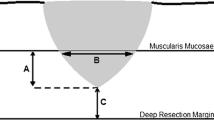Background:
The clinical utility of relative and absolute grading criteria for submucosal invasion in T1 colorectal carcinomas has been controversial. Methods: In 51 T1 colorectal carcinomas, depth of submucosal invasion was graded either according to a modified Haggitt's classification (a relative criterion) or by direct measurement using a micrometer (an absolute criterion), and immunostaining for E-cadherin, α-catenin, β-catenin, matrilysin, and CD44 variant 6 was performed on formalin-fixed, paraffin-embedded sections. The associations between lymph node metastasis or local recurrence (locoregional failure) and tumor budding, and clinicopathologic parameters and immunoreactivity were examined statistically. Results: By univariate analysis, tumor budding, histology, and the co-expression pattern of nuclear β-catenin and CD44 variant 6 were significantly associated with locoregional failure. The relative and absolute grading of submucosal invasion were not significantly associated with locoregional failure. Multivariate analysis showed that tumor budding alone was significantly associated with locoregional failure, and the association between the co-expression pattern of nuclear β-catenin and CD44 variant 6, and locoregional failure was marginally significant (P = 0.0502). Lymphatic invasion and absolute grading of depth and width of submucosal invasion were significantly associated with tumor budding, and the associations between tumor budding, and histologic differentiation and membranous α-catenin expression were marginally significant (P = 0.06; P = 0.08), whereas, a relative grading of submucosal invasion was not significant (P = 0.58). Analysis of variance showed that histologic differentiation and lymphatic invasion were independently and significantly associated with tumor budding (P = 0.005; P < 0.001). Conclusions: These results suggest that the grading of submucosal invasion, either relative or absolute, may not be a useful risk factor for lymph node metastasis or local recurrence in T1 colorectal carcinomas.
Similar content being viewed by others
Author information
Authors and Affiliations
Additional information
Received: January 16, 2002 / Accepted: May 17, 2002
Acknowledgements. We thank Drs. Y. Shimada, K. Nunomura, and S. Uchiyama for providing tissue blocks. For expert technical assistance we thank Ms. N. Shiota and Ms. K. Ooshima.
Reprint requests to: T. Masaki
Rights and permissions
About this article
Cite this article
Masaki, T., Sugiyama, M., Matsuoka, H. et al. Clinical utility of grading criteria for submucosal invasion in the prognosis of T1 colorectal carcinomas. J Gastroenterol 38, 37–44 (2003). https://doi.org/10.1007/s005350300004
Issue Date:
DOI: https://doi.org/10.1007/s005350300004




